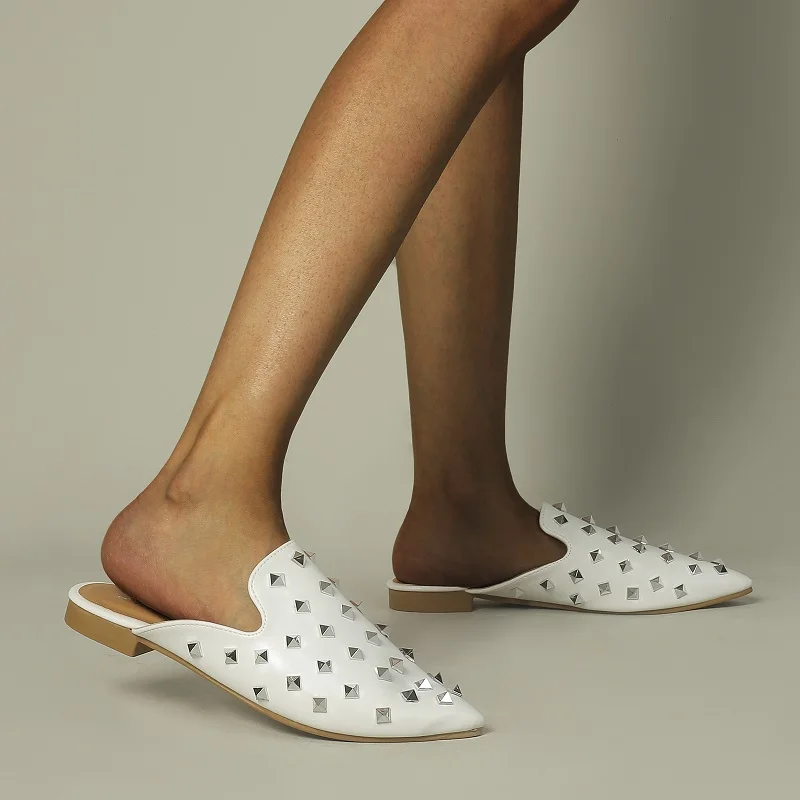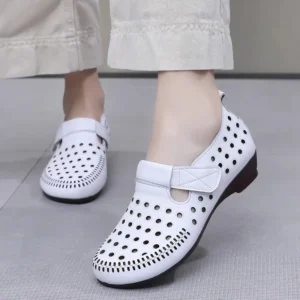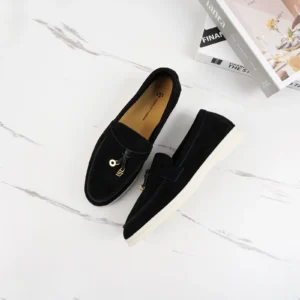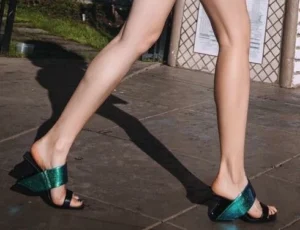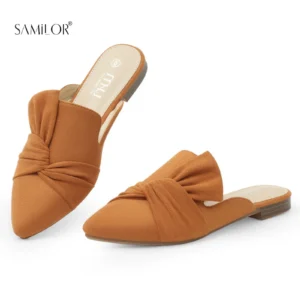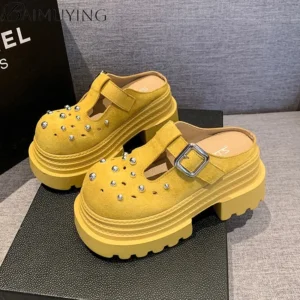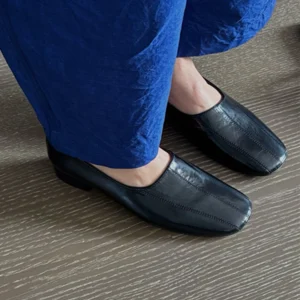Understanding Open Back Loafers: The Perfect Blend of Style and Convenience
Open back loafers represent a sophisticated evolution in footwear design—combining the classic front styling of traditional loafers with a convenient open heel that allows for effortless slip-on wear. These hybrid shoes offer the perfect balance between polished elegance and practical comfort, making them increasingly popular in modern fashion circles.
What sets open back loafers apart is their distinctive design profile:
- A structured vamp and toe area that maintains the sophisticated appearance of classic loafers
- The absence of a heel counter, creating an open back that allows feet to slide in easily
- A silhouette that bridges the gap between formal closed loafers and casual mules
- Design elements that maintain the shoe securely on the foot despite the open back
This innovative footwear style emerged as designers sought to create options that would accommodate busy lifestyles without sacrificing style. The result is a versatile shoe that works seamlessly across different settings, from professional office loafer outfits to casual weekend wear.
The appeal of open back loafers lies in their ability to offer multiple benefits simultaneously: the refined appearance of traditional loafers, the easy wearability of slides, and unique design elements that create visual interest from every angle. As contemporary fashion continues to prioritize both comfort and style, these shoes have evolved from a niche trend to a wardrobe staple.
Our curated collection of women’s loafer mules showcases the variety and versatility that has made this style increasingly popular among fashion-forward individuals seeking both sophistication and convenience in their footwear choices.
The Anatomy of Open Back Loafers: Key Design Elements
Understanding the fundamental components of open back loafers helps appreciate the craftsmanship and design considerations that go into creating these versatile shoes. Each element serves both aesthetic and functional purposes, working together to create a balanced and wearable shoe despite the unique challenges of an open back design.
The key anatomical elements include:
- Vamp – The upper portion covering the front of the foot, which must be thoughtfully designed to secure the shoe without a back
- Toe box – The forward section that determines both comfort and style, ranging from almond and pointed to square and round shapes
- Sole – The bottom layer providing structure, support, and traction, typically thinner in profile than closed loafers
- Heel – Usually low or flat, designed to balance the open back while maintaining stability
- Insole – The interior footbed where comfort features are concentrated to compensate for the lack of heel support
The proportions between these elements are critical in open back loafers. Without the security of a heel counter, designers must carefully balance the vamp coverage and depth to ensure the shoe stays on properly. Too shallow a vamp creates a shoe that slips off easily; too deep restricts the slip-on convenience that defines this style.
Manufacturers employ various techniques to achieve this balance, including strategic placement of elastic inserts, precise angling of the vamp opening, and thoughtful distribution of weight throughout the shoe structure. These adaptations allow mule loafers with open backs to remain secure on the foot while maintaining their signature silhouette and ease of wear.
The relationship between these components creates the distinctive profile that makes open back loafers immediately recognizable and increasingly popular among those seeking versatility in their footwear collection.
Vamp Variations: Distinctive Upper Designs and Embellishments
The vamp design is perhaps the most distinguishing feature of open back loafers, serving both aesthetic and functional purposes. This critical upper component helps secure the shoe on your foot while simultaneously establishing its style identity. At Artisan Haul, we’ve curated designs that showcase the impressive variety available in this footwear category.
Common vamp variations include:
- Penny loafer style – Featuring the iconic strap across the vamp with a diamond-shaped slot, adapting this classic detail to the open back silhouette
- Horsebit hardware – Metal embellishments across the vamp that add a touch of luxury and heritage appeal
- Tassel details – Decorative fringed leather pieces that bring movement and visual interest to the shoe’s front
- Kiltie fringe – A layered leather fringe that drapes over the vamp, adding texture and dimension
- Minimalist designs – Clean, unadorned vamps that emphasize sleek lines and quality materials
- Split-toe construction – Distinctive seaming that creates visual interest while enhancing flexibility
The height and coverage of the vamp significantly impact both the style and function of open back loafers. A higher vamp provides more security for the foot but may appear more conservative, while a lower vamp creates a more revealing look but requires additional design considerations to stay properly positioned on the foot.
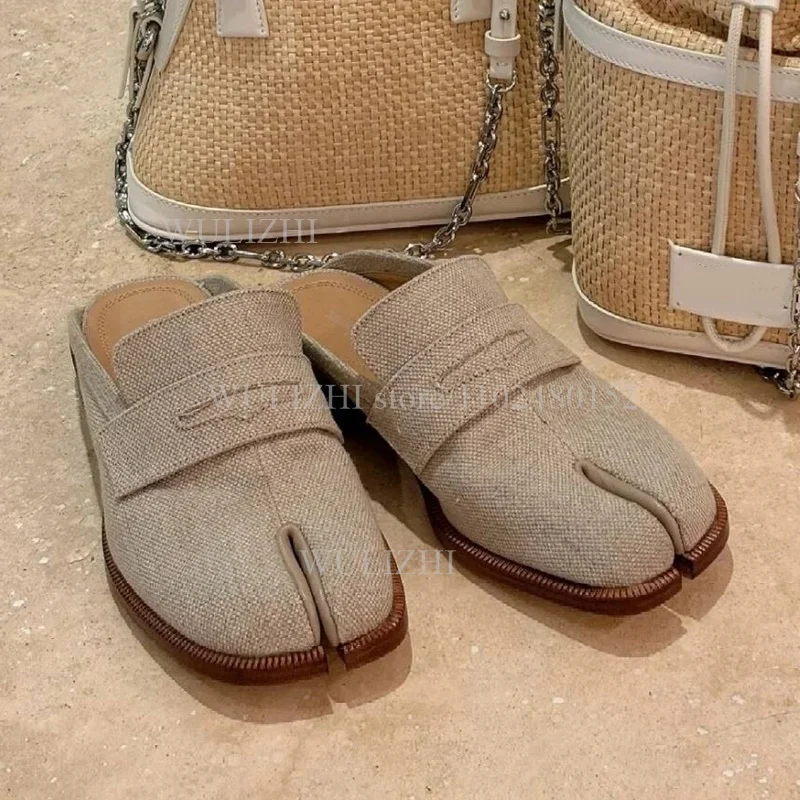
Embellishments on the vamp not only define the shoe’s aesthetic but can also add structural integrity. For instance, metal hardware adds weight to the front, helping balance the shoe despite its open back. The versatility of these design elements allows open back loafers to range from casual to formal, making women’s slingback loafers adaptable to various settings and outfits.
Material Matters: How Fabrics and Textures Define the Shoe
The materials selected for open back loafers significantly influence their appearance, durability, comfort, and care requirements. Quality materials not only enhance aesthetic appeal but also ensure the shoe performs well despite lacking the structural support of a closed back design.
Key material options include:
- Full-grain leather – The premium choice for durability and developing a beautiful patina over time; molds to the foot for improved fit with wear
- Suede and nubuck – Offers a soft, luxurious texture and casual elegance; requires more protection from moisture but provides visual depth
- Patent leather – Creates a glossy, formal appearance perfect for dressier occasions; tends to be more rigid initially but adds structure to the open design
- Vegan leather alternatives – Modern synthetic options providing animal-free choices with improving breathability and flexibility
- Textiles – Including velvet, canvas, and linen that add seasonal versatility and textural interest
- Exotic materials – Woven leather, raffia, and unique textures that create distinctive visual appeal and often seasonal specialization
Material selection impacts multiple aspects of the open back loafer experience:
- Comfort: Softer materials like suede conform more readily to the foot, while stiffer materials like patent leather may provide more structure
- Breathability: Natural materials generally allow better air circulation, an important consideration for shoes often worn without socks
- Seasonality: Heavier materials suit cooler weather, while lighter options like canvas work well for summer
- Care requirements: Each material demands specific maintenance approaches to maintain appearance and extend wear life
The relationship between material and construction becomes especially important in open back styles. Without the support of a heel counter, the material must maintain its shape while still providing flexibility where needed. Our collection of women’s suede flat loafers showcases how this luxurious material adapts beautifully to the open back silhouette.
Sole Construction: Balancing Style, Comfort, and Durability
The sole of an open back loafer plays a crucial role in both the shoe’s appearance and performance. Without the stability provided by a closed heel, sole construction becomes even more vital in ensuring comfort and durability while maintaining an elegant profile.
Common sole options include:
- Leather soles – Traditional and refined with a sleek profile; they provide a formal look but offer less traction and require breaking in
- Rubber soles – Practical and durable with excellent grip; modern thin rubber soles can maintain an elegant appearance while adding comfort
- Composite materials – Lightweight options that blend the appearance of leather with improved durability and flexibility
- Crepe soles – Natural rubber construction offering exceptional cushioning with a slightly casual appearance
- Lug soles – Chunky, textured options for contemporary styles that provide maximum traction and visual impact
The relationship between sole and upper is particularly important in open back designs. The sole must be appropriately proportioned to balance the visual weight of the vamp while providing adequate support. Too thin a sole may cause discomfort from lack of cushioning, while too thick a sole can make the shoe front-heavy and prone to slipping off.
Quality construction features to look for include:
- Channel stitching that recesses the stitches to prevent wear
- Beveled edges that create a refined profile
- Proper flexibility that allows natural foot movement
- Thoughtful transition between sole and upper for visual harmony
For professional environments, considering how the sole impacts the overall appearance is essential when wearing loafers to the office. A well-designed sole contributes significantly to both comfort throughout the day and appropriateness for business settings.
Heel Designs: Options Beyond the Traditional Flat
While many associate open back loafers with flat designs, heel variations add versatility and style dimension to this footwear category. The heel design significantly impacts the shoe’s silhouette, comfort level, and appropriate occasions for wear.
Common heel variations include:
- Classic flat profile – The most traditional approach, offering maximum stability and a sleek, understated look
- Mini stacked heels (0.25-0.5 inches) – Subtle elevation that maintains casual wearability while adding slight formality
- Low block heels (0.5-1 inch) – Provides comfortable elevation with stable support, bridging casual and formal styles
- Chunky statement heels – Contemporary interpretations featuring bold proportions and architectural designs
- Contrast materials – Heels that incorporate different colors or textures from the upper for visual interest
The heel design in open back loafers presents unique technical challenges. Without a closed counter to secure the foot, the heel must be strategically designed to maintain stability. Lower heels typically work better for this style, as higher elevations can cause the foot to slide forward and out of the shoe.
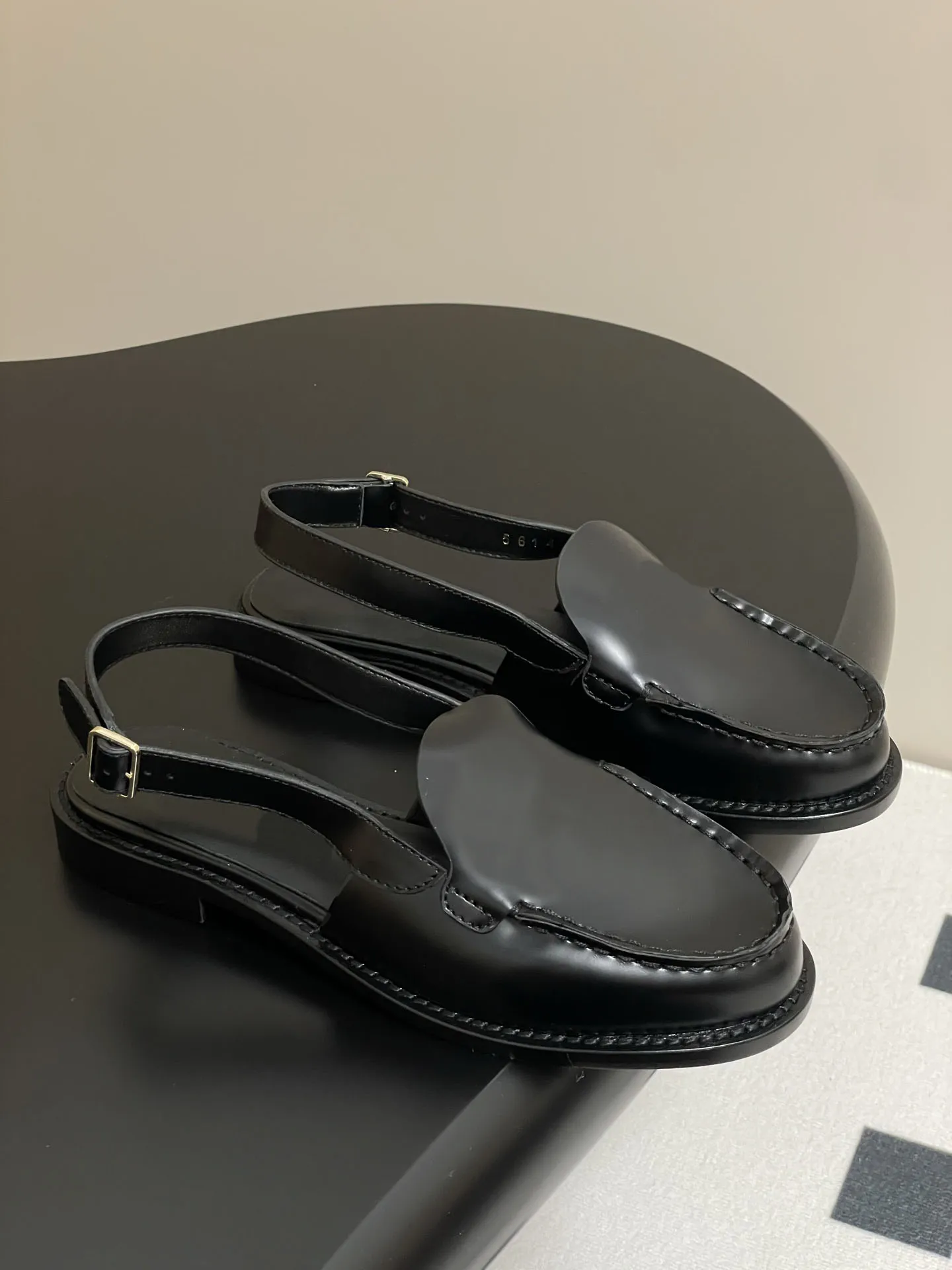
Designers address this challenge by carefully balancing heel height with vamp coverage and sometimes incorporating hidden elastic or strategically placed padding. The relationship between heel height and vamp depth becomes particularly important—deeper vamps can accommodate slightly higher heels without compromising fit.
For those seeking sleek, professional options, our women’s pointed toe flat loafers feature thoughtfully designed heel profiles that complement their elegant silhouettes while ensuring day-long comfort.
Comfort Features: Interior Design Elements That Make a Difference
The comfort of open back loafers depends significantly on thoughtful interior design elements that compensate for the lack of heel support. These often-hidden features make the difference between shoes that are merely stylish and those that deliver all-day wearability.
Essential comfort elements include:
- Cushioned insoles – Memory foam, gel inserts, or high-density padding that absorbs impact and provides support
- Arch support – Contoured footbeds that maintain proper foot alignment despite the open design
- Strategic padding – Extra cushioning at pressure points, particularly at the vamp edge where friction commonly occurs
- Breathable linings – Moisture-wicking materials that keep feet comfortable, especially important for barefoot wear
- Smooth interior seams – Finished edges that prevent irritation and blistering
- Heel grip materials – Slightly textured insole surfaces near the heel that help prevent foot sliding
The absence of a back makes these interior comfort features even more crucial. Without the stability of a heel counter, the shoe relies entirely on the vamp and insole design to keep it properly positioned on the foot. Manufacturers must solve the technical challenge of providing enough grip to secure the shoe without creating uncomfortable pressure points.
Quality open back loafers often feature hidden technical elements, such as:
- Slight elevation at the heel portion of the insole to keep the foot from sliding forward
- Imperceptible elastic inserts that flex with movement while maintaining shape
- Microtexture footbeds that enhance grip without causing irritation
- Graduated cushioning that distributes pressure evenly across the foot
These thoughtful design considerations explain why open back loafers have become popular for warm weather wear, as discussed in our guide to the benefits of slingback loafers in hot climates.
Finding the Perfect Fit: Design Considerations for Security and Comfort
The unique construction of open back loafers presents specific fit challenges that manufacturers address through careful design considerations. Understanding these elements helps shoppers identify styles that will provide secure, comfortable wear.
Key fit factors include:
- Vamp coverage – The optimal amount of upper material to secure the foot without restricting entry; generally needs to be more substantial than in closed-back styles
- Width proportions – The relationship between the widest part of the foot and the shoe’s width; too narrow creates pressure points while too wide allows slipping
- Toe box shape – The amount of space provided for toes, which affects both comfort and the tendency for feet to slide forward
- Instep accommodation – How the shoe accounts for the height of the foot’s arch area, which varies significantly between individuals
When evaluating fit in open back loafers, consider these guidelines:
- The widest part of your foot should align with the widest part of the shoe
- Your toes should have room to lie flat without compression
- The vamp should feel secure without pinching or creating pressure points
- When walking, your heel should stay within the footbed rather than extending beyond it
- The shoe should move with your foot rather than slipping or flopping
Different foot shapes may require different design approaches. Higher arches often benefit from styles with more vamp coverage, while lower insteps may work better with slightly narrower proportions that hug the foot more closely.
Many of the comfort features in everyday loafers apply to open back styles as well, but with additional emphasis on elements that enhance security without sacrificing the ease of slip-on wear.
Contemporary Design Trends: Modern Interpretations of Open Back Loafers
Today’s designers are reimagining open back loafers with bold new interpretations that respect traditional elements while introducing fresh perspectives. These contemporary trends expand the versatility and appeal of this footwear category.
Current design innovations include:
- Exaggerated proportions – Chunky, platform soles that create dramatic silhouettes while maintaining the essential loafer character
- Material mixing – Strategic combinations of contrasting textures like smooth leather with suede, or natural materials with metallics
- Architectural approaches – Sculpted components with unusual angles and cutouts that create visual interest
- Color exploration – Bold hues and color blocking that transform classic silhouettes into statement pieces
- Minimalist reductions – Streamlined versions that strip away traditional details for clean, modern lines
- Unexpected embellishments – Contemporary hardware, unusual textures, and non-traditional decorative elements
These modern interpretations benefit from advances in manufacturing techniques that allow for more complex constructions while maintaining comfort. Computer-aided design and improved materials have enabled designers to push boundaries while ensuring wearability.
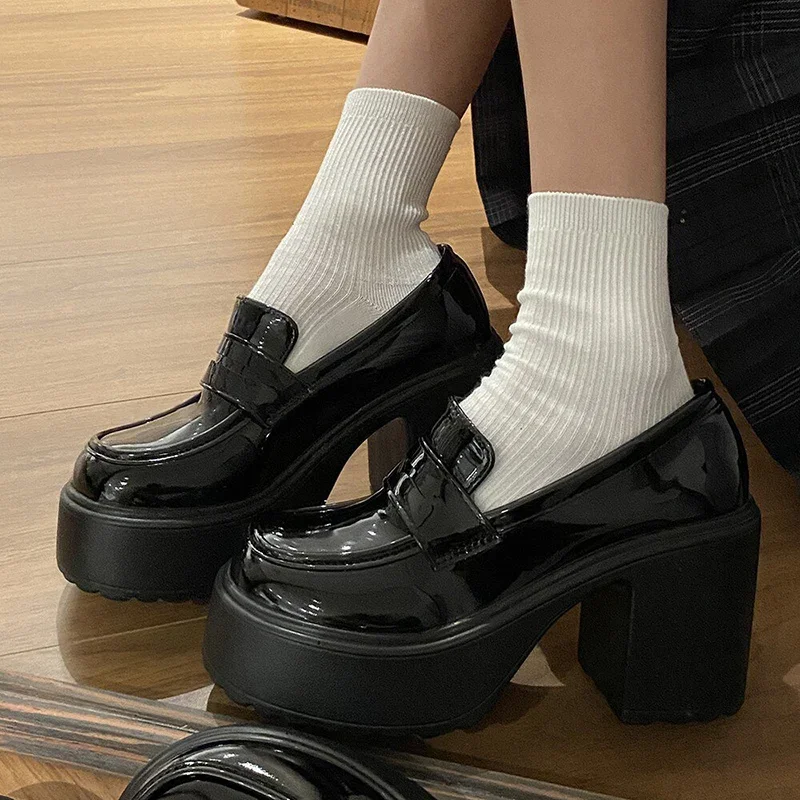
The evolution of open back loafers reflects broader fashion trends toward versatile pieces that bridge casual and formal categories. The most successful contemporary designs maintain the essential DNA of loafers while introducing elements that feel fresh and relevant.
Our collection of women’s mule slingback loafers showcases how traditional loafer elements can be reinterpreted with modern sensibilities while maintaining the quality craftsmanship that ensures lasting value.
Styling Versatility: Design Features That Enhance Wearability
Certain design elements significantly impact the styling versatility of open back loafers, determining how easily they transition between different outfits and occasions. Understanding these features helps in selecting pairs that provide maximum wardrobe flexibility.
Key design aspects that affect versatility include:
- Toe shape – Rounded toes typically read as more casual, while pointed toes create a dressier impression suitable for formal settings
- Material finish – Glossy surfaces like patent leather signal formality, while matte finishes like suede tend toward casual versatility
- Color selection – Neutral tones maximize versatility, while statement colors create focal points but may limit pairing options
- Hardware size and finish – Subtle, tonal hardware offers greater versatility than bold, contrasting embellishments
- Sole profile – Thinner soles typically transition more easily to formal settings, while chunkier styles make stronger casual statements
The inherent design of open back loafers creates natural versatility by combining the refined front of a classic loafer with the relaxed ease of a mule. This hybrid quality allows them to bridge wardrobe categories more effectively than many other footwear styles.
For professional environments, selecting open back loafers with more conservative elements helps create appropriate business casual loafer outfits while maintaining comfort throughout the workday. Features like modest hardware, refined materials, and structured shapes enhance workplace suitability.
The most versatile designs typically feature:
* Classic color palettes (black, navy, tan, burgundy)
* Medium toe shapes (slightly almond or softly pointed)
* Minimal to moderate embellishments
* Quality materials with subtle texture
* Well-proportioned soles that balance style and comfort
Women's Comfortable Flat Loafers, Women's Leather Flat Loafers, Women's Round Toe Flat Loafers
$124.88 Select options This product has multiple variants. The options may be chosen on the product pageWomen's Loafer Mules, Women's Suede Flat Loafers
$190.23 Select options This product has multiple variants. The options may be chosen on the product page- $220.29 Select options This product has multiple variants. The options may be chosen on the product page
Women's Loafer Mules, Women's Pointed Toe Flat Loafers
Price range: $113.22 through $146.02 Select options This product has multiple variants. The options may be chosen on the product pageWomen's High Platform Loafers, Women's Loafer Mules
Price range: $145.30 through $184.32 Select options This product has multiple variants. The options may be chosen on the product pageWomen's Block Heel Loafers, Women's Leather Flat Loafers, Women's Leather Penny Loafers
$295.19 Select options This product has multiple variants. The options may be chosen on the product page
Premium Design Indicators: What Sets Quality Open Back Loafers Apart
The difference between ordinary and exceptional open back loafers often lies in subtle design details that signal quality craftsmanship. These premium indicators reflect both aesthetic refinement and structural integrity that translates to superior comfort and longevity.
Key hallmarks of premium design include:
- Edge finishing – Cleanly cut, beveled, and painted edges with consistent coloration that prevents fraying and enhances appearance
- Precision stitching – Even, tight seams with consistent stitch length and proper tension, particularly visible around the vamp
- Material selection – Full-grain leathers with natural markings, even dye penetration, and appropriate thickness for each shoe component
- Hardware attachment – Metal elements securely anchored with reinforced backing to prevent loosening over time
- Sole integration – Smooth transition between upper and sole with hidden construction methods rather than visible glue
- Interior finishing – Fully lined interiors with no exposed rough surfaces, properly secured insoles, and thoughtful padding
Beyond these technical elements, premium open back loafers demonstrate masterful proportions—the balanced relationship between toe shape, vamp height, sole thickness, and overall silhouette. This harmony of elements creates an aesthetically pleasing design that flatters the foot.
Quality manufacturers also pay particular attention to the weight distribution in open back styles, ensuring the shoe balances properly despite lacking a heel counter. This engineering consideration significantly impacts comfort during extended wear.
Our collection of women’s leather flat loafers exemplifies these premium design indicators, showcasing the attention to detail that elevates simple silhouettes to investment-worthy wardrobe additions.
How to Evaluate Open Back Loafer Design: A Practical Guide
When assessing open back loafer options, a systematic approach helps identify pairs that combine aesthetic appeal with practical wearability. This evaluation framework focuses on both visible design elements and functional considerations.
Use this checklist when evaluating potential purchases:
Visual Balance Assessment
* Does the shoe maintain an appealing silhouette from all angles?
* Is the proportion between vamp coverage and open back visually harmonious?
* Does the toe shape complement the overall design without appearing exaggerated?
* Is the transition between materials and components smooth and intentional?
Material Quality Indicators
* Do leather surfaces show natural grain variation rather than artificial uniformity?
* Are edges cleanly finished with consistent coloration?
* Do materials feel substantial without being overly rigid?
* Is there appropriate flexibility at key points where the foot bends?
Construction Quality Check
* Are stitches even, tight, and properly recessed where needed?
* Is hardware securely attached without visible glue or irregular edges?
* Does the sole attach to the upper with clean, precise lines?
* Are interior components fully secured without wrinkles or gaps?
Comfort Verification
* Does the footbed provide adequate cushioning, particularly at the ball of the foot?
* Is there sufficient arch support for your foot type?
* Does the vamp hold the foot securely without creating pressure points?
* Can you walk naturally without the shoe slipping off or requiring toe gripping?
When balancing aesthetic preferences with practical concerns, prioritize fit and basic comfort while being willing to compromise slightly on purely decorative elements. A beautifully designed shoe that causes discomfort ultimately fails regardless of its visual appeal.
Understanding the Value Equation: Why Design Details Matter
The thoughtful design elements incorporated into quality open back loafers justify their position as investment pieces rather than merely fashionable accessories. These details directly impact both immediate satisfaction and long-term value.
Well-designed open back loafers deliver multiple benefits that enhance their overall value proposition:
- Versatility that reduces cost-per-wear by functioning across multiple outfit categories
- Comfort features that encourage regular use rather than occasional wear
- Durable construction that extends useful life beyond seasonal trends
- Timeless design elements that resist fashion obsolescence
- Quality materials that improve with wear rather than deteriorating
The relationship between design integrity and satisfaction becomes particularly evident in open back styles, where poor engineering quickly results in shoes that slip off, cause discomfort, or lose their shape. Superior design solves these inherent challenges through thoughtful material selection, precise construction, and attention to functional details.
At Artisan Haul, we carefully evaluate each design element to ensure our open back loafers deliver exceptional quality and lasting value. By understanding and appreciating these nuanced design features, you can make informed choices that enhance your wardrobe with pieces that provide both immediate pleasure and lasting satisfaction.

